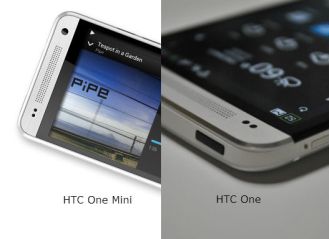It’s been a dream of gadget aficionados for years: a high-end Android phone that isn’t so friggin’ big. Every so often, someone writes an article bemoaning the fact that such a phone doesn’t exist, only to have their prayers ignored as Android phones get bigger and bigger.
The HTC One Mini could have been that little powerhouse. In rumors, it had a lot of things you’d want in a premium phone–aluminum chassis, speedy processor, high pixel-density display–but with a 4.3-inch display instead of the One’s 4.7-inch screen.
Now that the phone has been officially announced, we can see just how close the One Mini came to being that smaller, premium phone, while still falling victim to the idea that a small screen necessitates an inferior phone.
Though I haven’t used the One Mini myself, I expect that its dual-core Snapdragon 400 processor should be speedy enough for most tasks, and its 720p display should be sharp enough that it’ll be tough to tell the difference from the 1080p screen on the larger One. The “UltraPixel” camera and extra-loud front-facing speakers, both hallmark features of the HTC One, remain intact.
Unfortunately, HTC did make some sacrifices: It has half the RAM, at 1 GB, and half the storage, at 16 GB (with no memory card expansion); it lacks an IR blaster for controlling your television; its rear camera doesn’t have optical image stabilization; and its front-facing camera has a lower resolution of 1.6 megapixels.

There’s also something a little different about the design of the HTC One Mini. If you look at photos of the device, you’ll see that the plastic frame on the edges of the phone extend all the way to the front and back panels. On the regular One, the black glass on the screen extends downward, flanked by shiny metal trim on either side. That same metal trim runs around the bottom panel of the phone. It’s a subtle design touch that really adds to the HTC One’s beauty, and it’s missing from the One Mini.
We’ve been down this road before. Samsung’s 4.3-inch Galaxy S4 Mini is even more compromised than its larger sibling, with merely a 960-by-540 resolution screen, a weaker processor and and half the storage. Last year, Motorola’s Droid Razr M had half the storage of the larger Razr M and a much uglier display. (Next week, Verizon is likely to announce a trio of new Motorola Droid phones; I’ll be shocked if the rumored Droid Mini isn’t somehow inferior to its larger counterparts.)
Just like Samsung and Motorola, HTC made sacrifices with the One Mini in pursuit of a smaller price tag, probably to appeal to overseas markets where subsidized phone prices aren’t an option. Although pricing hasn’t been announced, The Verge cites an unnamed HTC representative as saying the One Mini is “two price points below the HTC One.” The idea that people might be willing to pay just as high of a price for a smaller phone, particularly in the United States, seems lost on all the major phone makers.
And hey, maybe the phone makers are right, and the ever-complaining tech press is just a vocal minority. I’ll admit that for high-end Android phones, a larger screen makes for an easy point of differentiation against Apple‘s iPhone. Maybe a small, high-end Android phone would be total flop.
The frustrating thing is that no Android phone maker has even bothered to find out. Not a single company has stepped up and tried to make a no-compromise phone with a 4.3-inch or smaller display. For all the talk of how much choice Android allows, your options for high-end phones are limited to screens of 4.7 inches and larger. And those screens keep getting larger.
I’m not making a plea for my own personal gain. My day-to-day phone is a full-sized HTC One, and while my hands sometimes get tired of stretching across the large screen, I’m not sure if I’d ever go back to a smaller handset. Still, I’ve got to believe there’s a market for smaller phones that don’t skimp on quality, and that phone makers missing the opportunity. For now, that theory remains untested.

